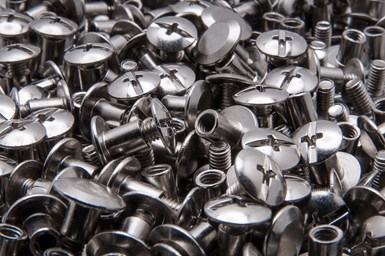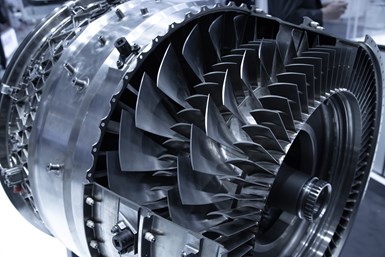by
Shay Davis, CHEMEON Surface Technology
James Wetherald, Ronatec C2C
Joe Zabielski, Ronatec C2C
Abstract
This report documents the evaluation of a trivalent chromium pretreatment (TCP), or trivalent chem film, as a “post coating,” or top coat, to most commonly used electroless nickel processes on the market within the USA, Canada, Mexico, Europe, Asia and South America to improve corrosion resistance. Ronatec C2C Inc. has compiled and combined eighteen months of testing and data below for review.
All testing used an average of four panels plated/coated with the test parameters detailed below at 1-mil (0.001-inch or 0.0254-mm) thickness. The goal was to meet or exceed the specification-neutral salt spray requirements, and discontinue salt spray upon visible red rust formation for all tests — comparing each process with and without a TCP top coat.

Introduction
Electroless nickel was accidentally discovered in 1844, and defined further in 1911. The controlled plating process was developed, also by accident, in 1946, and later refined into today’s common processes. Electroless nickel (EN) plating is a method dependent upon a chemical solution as the catalyst for reducing nickel ions and the deposition of the resulting nickel alloy onto a substrate such as metal or plastic.
Electroless nickel plating has a wide range of capabilities and — often underappreciated — benefits in industries such as oil & gas, aviation, automotive, decorative and electrical. The uniform deposition of the coating (regardless of the substrate surface geometry), hardness and magnetic response are some of electroless nickel’s unique properties. Electroless nickel has an ultrafine amorphous structure and provides more protection from corrosion. The following testing was performed to further improve upon the natural structure.
Methods
Six tests with Restriction of Hazardous Substances Directive (RoHS)-compliant EN and 4130 steel panels were conducted. Each test utilized a Ronatec-proprietary panel preparation cycle (PPC) and Ronatec EN test panel rack, RC100.
Mid-Phosphorus – per MIL-DTL-26074 and AMS2404 specifications - Ronatec RoHS EN1000
Test #1 – Process parameters (without CHEMEON TCP-HF top coat)
- 5 minutes Ronatec ST-100 soak clean (0.5lb/gal, 150ºF, agitated)
- 30 seconds rinse (DI water, ambient, non-agitated)
- 60 seconds rinse (<1MSM overflowing to Ronatec water recycling system, ambient)
- 2 minutes Ronatec E-100 ElectroClean (0.5lb/gal, 120ºF, forward & reverse cyclical current)
- 30 seconds rinse (DI water, ambient, non-agitated)
- 60 seconds rinse (<1MSM overflowing to Ronatec water recycling system, ambient)
- 1 minute Ronatec ST Act-1 Activator (0.25lb/gal, ambient)
- 30 seconds rinse (DI water, ambient, non-agitated)
- 60 seconds rinse (<1MSM overflowing to Ronatec water recycling system, ambient)
- 72 minutes Ronatec EN1000 Mid Phos EN (full concentration, pH 4.91, 189ºF, 1-mil (10/10ths) build thickness)
- 30 seconds rinse (DI water, ambient, non-agitated)
- 60 seconds rinse (<1MSM overflowing to Ronatec water recycling system, ambient)
- 60 seconds rinse (<1MSM overflowing to Ronatec water recycling system, 170ºF)
Test #2 – Process parameters (with CHEMEON TCP-HF top coat)
- 5 minutes Ronatec ST-100 soak clean (0.5lb/gal, 150ºF, agitated)
- 30 seconds rinse (DI water, ambient, non-agitated)
- 60 seconds rinse (<1MSM overflowing to Ronatec water recycling system, ambient)
- 2 minutes Ronatec E-100 ElectroClean (0.5lb/gal, 120ºF, forward & reverse cyclical current)
- 30 seconds rinse (DI water, ambient, non-agitated)
- 60 seconds rinse (<1MSM overflowing to Ronatec water recycling system, ambient)
- 1 minute Ronatec ST Act-1 Activator (0.25lb/gal, ambient)
- 30 seconds rinse (DI water, ambient, non-agitated)
- 60 seconds rinse (<1MSM overflowing to Ronatec water recycling system, ambient)
- 72 minutes Ronatec EN1000 Mid Phos EN (full concentration, pH 4.91, 189ºF, 1-mil (10/10ths) build thickness)
- 30 seconds rinse (DI water, ambient, non-agitated)
- 60 seconds rinse (<1MSM overflowing to Ronatec water recycling system, ambient)
- 6 minutes CHEMEON TCP-HF (28% concentration, 80ºF, DI water make-up)
- 30 seconds rinse (<1MSM overflowing to Ronatec water recycling system, ambient)
High-Speed High-Phosphorus – per MIL-DTL-26074 and AMS2404 specifications - Ronatec RoHS EN1012
Test #3 – Process parameters (without CHEMEON TCP-HF top coat)
- 5 minutes Ronatec ST-100 soak clean (0.5lb/gal, 150ºF, agitated)
- 30 seconds rinse (DI water, ambient, non-agitated)
- 60 seconds rinse (<1MSM overflowing to Ronatec water recycling system, ambient)
- 2 minutes Ronatec E-100 ElectroClean (0.5lb/gal, 120ºF, forward & reverse cyclical current)
- 30 seconds rinse (DI water, ambient, non-agitated)
- 60 seconds rinse (<1MSM overflowing to Ronatec water recycling system, ambient)
- 1 minute Ronatec ST Act-1 Activator (0.25lb/gal, ambient)
- 30 seconds rinse (DI water, ambient, non-agitated)
- 60 seconds rinse (<1MSM overflowing to Ronatec water recycling system, ambient)
- 87 minutes Ronatec EN1012 High Phos EN (full concentration, pH 4.89, 189ºF, 1-mil (10/10ths) build thickness)
- 30 seconds rinse (DI water, ambient, non-agitated)
- 60 seconds rinse (<1MSM overflowing to Ronatec water recycling system, ambient)
- 60 seconds rinse (<1MSM overflowing to Ronatec water recycling system, 170ºF)
Test #4 – Process parameters (with CHEMEON TCP-HF top coat)
- 5 minutes Ronatec ST-100 soak clean (0.5lb/gal, 150ºF, agitated)
- 30 seconds rinse (DI water, ambient, non-agitated)
- 60 seconds rinse (<1MSM overflowing to Ronatec water recycling system, ambient)
- 2 minutes Ronatec E-100 ElectroClean (0.5lb/gal, 120ºF, forward & reverse cyclical current)
- 30 seconds rinse (DI water, ambient, non-agitated)
- 60 seconds rinse (<1MSM overflowing to Ronatec water recycling system, ambient)
- 1 minute Ronatec ST Act-1 Activator (0.25lb/gal, ambient)
- 30 seconds rinse (DI water, ambient, non-agitated)
- 60 seconds rinse (<1MSM overflowing to Ronatec water recycling system, ambient)
- 87 minutes Ronatec EN1012 High Phos EN (full concentration, pH 4.91, 189ºF, 1-mil (10/10ths) build thickness)
- 30 seconds rinse (DI water, ambient, non-agitated)
- 60 seconds rinse (<1MSM overflowing to Ronatec water recycling system, ambient)
- 6 minutes CHEMEON TCP-HF (28% concentration, 80ºF, DI water make-up)
- 30 seconds rinse (<1MSM overflowing to Ronatec water recycling system, ambient)
High-Speed High-Phosphorus with PTFE Co-Deposit – per MIL-DTL-26074 and AMS2404 specifications - Ronatec RoHS EN1015
Test #5 – Process parameters (without CHEMEON TCP-HF top coat)
Featured Content
- 5 minutes Ronatec ST-100 soak clean (0.5lb/gal, 150ºF, agitated)
- 30 seconds rinse (DI water, ambient, non-agitated)
- 60 seconds rinse (<1MSM overflowing to Ronatec water recycling system, ambient)
- 2 minutes Ronatec E-100 ElectroClean (0.5lb/gal, 120ºF, forward & reverse cyclical current)
- 30 seconds rinse (DI water, ambient, non-agitated)
- 60 seconds rinse (<1MSM overflowing to Ronatec water recycling system, ambient)
- 1 minute Ronatec ST Act-1 Activator (0.25lb/gal, ambient)
- 30 seconds rinse (DI water, ambient, non-agitated)
- 60 seconds rinse (<1MSM overflowing to Ronatec water recycling system, ambient)
- 135 minutes Ronatec EN1015 High Phos EN (full concentration, pH 4.88, 191ºF, 1-mil (10/10ths) build thickness, 6 g/L PTFE) - multi-step proprietary process
- 30 seconds rinse (DI water, ambient, non-agitated)
- 60 seconds rinse (<1MSM overflowing to Ronatec water recycling system, ambient)
- 60 seconds rinse (<1MSM overflowing to Ronatec water recycling system, 170ºF)
Test #6 – Process parameters (with CHEMEON TCP-HF top coat)
- 5 minutes Ronatec ST-100 soak clean (0.5lb/gal, 150ºF, agitated)
- 30 seconds rinse (DI water, ambient, non-agitated)
- 60 seconds rinse (<1MSM overflowing to Ronatec water recycling system, ambient)
- 2 minutes Ronatec E-100 ElectroClean (0.5lb/gal, 120ºF, forward & reverse cyclical current)
- 30 seconds rinse (DI water, ambient, non-agitated)
- 60 seconds rinse (<1MSM overflowing to Ronatec water recycling system, ambient)
- 1 minute Ronatec ST Act-1 Activator (0.25lb/gal, ambient)
- 30 seconds rinse (DI water, ambient, non-agitated)
- 60 seconds rinse (<1MSM overflowing to Ronatec water recycling system, ambient)
- 135 minutes Ronatec EN1015 High Phos EN (full concentration, pH 4.88, 191ºF, 1-mil (10/10ths) build thickness) - multi-step proprietary process
- 30 seconds rinse (DI water, ambient, non-agitated)
- 60 seconds rinse (<1MSM overflowing to Ronatec water recycling system, ambient)
- 6 minutes CHEMEON TCP-HF (28% concentration, 80ºF, DI water make-up)
- 30 seconds rinse (<1MSM overflowing to Ronatec water recycling system, ambient)

Results
Operators tested panels in accordance with ASTM B117 neutral salt spray (NSS) exposure, and terminated upon signs of red rust development. Please note that higher salt spray hours are difficult to monitor on an hourly basis, thus data concludes the last time panels were viewed prior to showing “red rust.” Table I details the tests with corresponding data and results.
Table I Results – Four coatings tested against ASTM B117 neutral salt spray exposure.
| Test # | EN, Thickness | TCP | PTFE | Specification(s) | NSS Goal / Actual (hrs) | Top Coat TCP Improvement (%) |
| 1 | Mid-Phos, 1 mil, Ronatec RoHS EN1000 | No | — | MIL-DTL-26074 | 100 / 210 | — |
| 2 | Mid-Phos, 1 mil, Ronatec RoHS EN1000 | Yes | — | MIL-DTL-26074 | 100 / 286 | 36 |
| 3 | High-Phos, 1 mil Ronatec ROHS EN1012 | No | No | MIL-DTL-26074, ASTM B733 Type 5 | 1000 / 1410 | — |
| 4 | High-Phos, 1 mil Ronatec ROHS EN1012 | Yes | No | MIL-DTL-26074, ASTM B733 Type 5 | 1000 / 1520 | 8 |
| 5 | High-Phos PTFE, 1 mil, Ronatec RoHS EN1015 | No | Yes | MIL-DTL-26074, ASTM B733 Type 5 | 1000 / 1560 | — |
| 6 | High-Phos PTFE, 1 mil, Ronatec RoHS EN1015 | Yes | Yes | MIL-DTL-26074, ASTM B733 Type 5 | 1000 / 1760 | 12.8 |
Discussion
All tests passed specification requirements for neutral salt spray hours of exposure. The results support the theory that adding a trivalent chem film (CHEMEON TCP-HF) significantly increases the corrosion resistance of various electroless nickel coatings.
It is vital to note that electroless nickel concentrations were maintained and that these cycles were run in a lab setting. Rinses were clean DI utilizing a pre-set microsiemens water quality standard. Optimal tank layout, filtration, ventilation and controlled heating ensured the best results. Please contact Ronatec for details. As a note, Ronatec’s exact RoHS EN1015 process is proprietary to Ronatec customers only, and the full process is not as described above.
Based on the test data using Ronatec’s electroless nickel processes for mid phosphorus, and high speed phosphorus with and without PTFE, CHEMEON concludes that its TCP-HF trivalent top coat is an effective addition to the EN process.
Future Testing
Ronatec is currently conducting testing to include the following parameters:
- Mid-Phos baked for hydrogen embrittlement, then top coat of TCP-HF
- Mid-Phos, coat of TCP HF, then PTFE post dip
- High-Speed High-Phos PTFE (PFOA free) with TCP-HF

Administrative Information
James Wetherald (Ronatec VP) and Joe Zabielski (Ronatec Technical Director) of Ronatec C2C Inc. in Oceanside, Ca. performed the work described in this report with the use of Ronatec’s laboratory facilities and its customer facilities.
Acknowledgements
CHEMEON would like to thank Ronatec C2C Inc. for performing all of the testing, and providing the data through completion. CHEMEON and Ronatec greatly appreciate and thank Ronatec’s customer base for allowing the use of their facilities for testing through completion.
References
“Electroless Nickel Plating (EN Plating).” CORROSIONPEDIA, 28 Aug. 2014, updated 31 Dec. 2019, www.corrosionpedia.com/definition/438/electroless-nickel-plating-en-plating.
Parkinson, Ron. “Properties and Applications of Electroless Nickel.” Nickel Institute, Nickel Development Institute, nickelinstitute.org/media/1769/propertiesandapplicationsofelectrolessnickel_10081_.pdf.
RELATED CONTENT
-
An Overview of Hard Chromium Plating Using Trivalent Chromium Solutions
For more than forty years, academic and industrial researchers from all over the world have taken a strong interest in alternative processes for hard chromium plating using hexavalent ions. The benefits of substitute processes are obvious, as the toxic and carcinogenic aspects of hexavalent chromium are well known.
-
NOx Scrubbing Technology Breakthrough
This paper presents research findings and practical results that address the treatment of the problematic greenhouse gases nitrogen oxides (NOx) and sulfur dioxide (SO2).
-
Passivation Basics
What is commonly referred to as "passivating" on a shop floor is actually just enhancement of a naturally occurring process on most stainless steels.



















